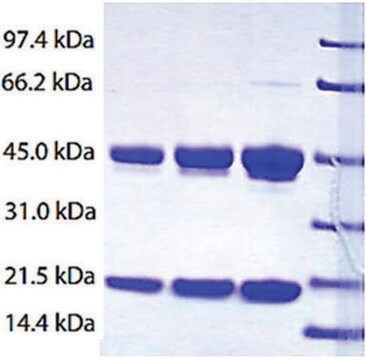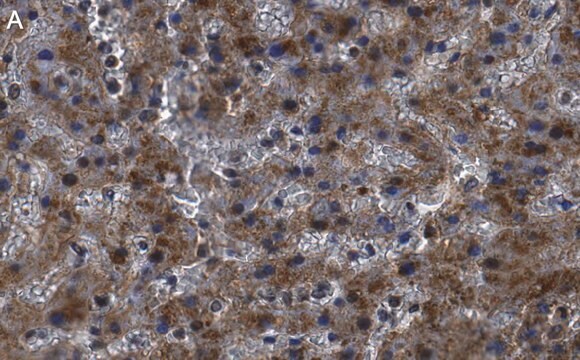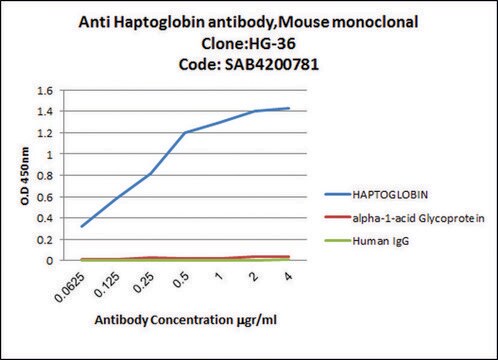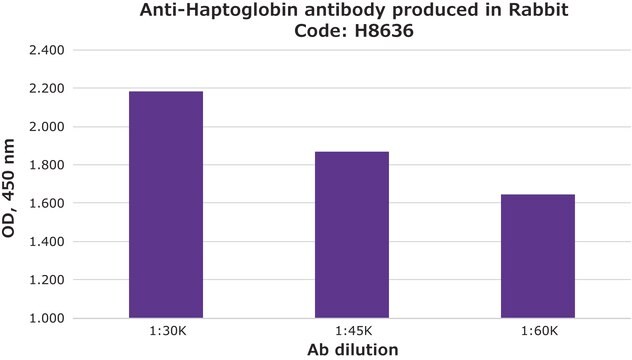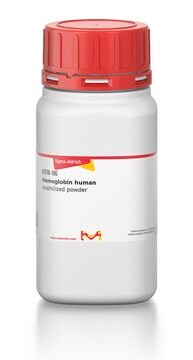H6395
Monoclonal Anti-Haptoglobin antibody produced in mouse
clone HG-36, ascites fluid
Sign Into View Organizational & Contract Pricing
All Photos(1)
About This Item
Recommended Products
biological source
mouse
Quality Level
conjugate
unconjugated
antibody form
ascites fluid
antibody product type
primary antibodies
clone
HG-36, monoclonal
contains
15 mM sodium azide
species reactivity
human
technique(s)
indirect ELISA: 1:4,000
isotype
IgG1
UniProt accession no.
shipped in
dry ice
storage temp.
−20°C
target post-translational modification
unmodified
Gene Information
human ... HP(3240)
General description
Monoclonal anti-Human Haptoglobin (mouse IgG1 isotype) is derived from the hybridoma produced by the fusion of mouse myeloma cells and splenocytes from an immunized mouse. Haptoglobin (Hp) is a serum α 2-glycoprotein that exists as a tetramer, composed of two smaller identical α chains and two larger identical β chains. The α-chains are linked to each other by a disulfide bond and each β-chain is similarly linked to an α-chain. Plasma haptoglobin is structurally similar to serum immunoglobulins. Haptoglobin is found in normal plasma at a concentration of 0.3-1.9 mg/ml and accounts for 0.4-2.6% of the total plasma proteins. It is also one of the groups of plasma proteins known as acute phase reactants.
Specificity
The antibody is specific for the 3 major haplotypes of human haptoglobin (Types 1-1, 2-1 and 2-2). It does not cross-react with human IgG, transferrin, C-reactive protein, α1-acid glycoprotein, albumin or hemoglobin using ELISA or immunoblotting methods. The antibody recognizes human haptoglobin as purified antigen, in human serum, or when complexed with human hemoglobin in a native or denatured, but non-reduced state.
Application
Applications in which this antibody has been used successfully, and the associated peer-reviewed papers, are given below.
Western Blotting (1 paper)
Western Blotting (1 paper)
Monoclonal Anti-Haptoglobin antibody produced in mouse has been used in enzyme-linked immunosorbent assay (ELISA) to determine plasma haptoglobin (Hp) levels and to probe duplicate dot blot strips for dot blot assay. It has been used in affinity purification of human high-density lipoprotein (HDL) to obtain trypanosome lytic factor (TLF) and also to prepare an affinity resin.
Biochem/physiol Actions
The most characteristic property of haptoglobin is its ability to form stable complexes with extra-corpuscular-free native hemoglobin that has been released during hemolysis and is thus thought to prevent iron loss through urinary excretion and to also prevent renal damage from the hemoglobin. In addition, the native form or normal plasma haptoglobin has been shown to exhibit a broad spectrum of immunosuppressive effects in the immune system. Measurement of haptoglobin levels may therefore be used to monitor the progress of inflammatory reactions and assess the efficiency of test drugs.
Disclaimer
Unless otherwise stated in our catalog or other company documentation accompanying the product(s), our products are intended for research use only and are not to be used for any other purpose, which includes but is not limited to, unauthorized commercial uses, in vitro diagnostic uses, ex vivo or in vivo therapeutic uses or any type of consumption or application to humans or animals.
Not finding the right product?
Try our Product Selector Tool.
Storage Class Code
10 - Combustible liquids
WGK
nwg
Flash Point(F)
Not applicable
Flash Point(C)
Not applicable
Choose from one of the most recent versions:
Already Own This Product?
Find documentation for the products that you have recently purchased in the Document Library.
Human plasma protein N-glycosylation
Clerc F, et al.
Glycoconjugate Journal, 33(3), 309-343 (2016)
A Zauberman et al.
The Journal of biological chemistry, 276(27), 24719-24725 (2001-05-02)
Activin A, a member of the transforming growth factor beta (TGFbeta) superfamily, blocks interleukin (IL)-6 biological functions. The molecular basis of the influence of this TGFbeta signaling on the IL-6 receptor triggered cascade is unknown. We studied IL-6-induced secretion of
Identification and purification of a hemoglobin-binding outer membrane protein from Neisseria gonorrhoeae.
Chen CJ, et al.
Infection and Immunity, 64(12), 5008-5014 (1996)
Plasma proteomic profile of sulfur mustard exposed lung diseases patients using 2-dimensional gel electrophoresis
Mehrani H, et al.
Clinical Proteomics, 8(1), 2-2 (2010)
Trypanosome lytic factor, an antimicrobial high-density lipoprotein, ameliorates Leishmania infection
Samanovic M, et al.
PLoS Pathogens, 5(1), e1000276-e1000276 (2009)
Our team of scientists has experience in all areas of research including Life Science, Material Science, Chemical Synthesis, Chromatography, Analytical and many others.
Contact Technical Service

